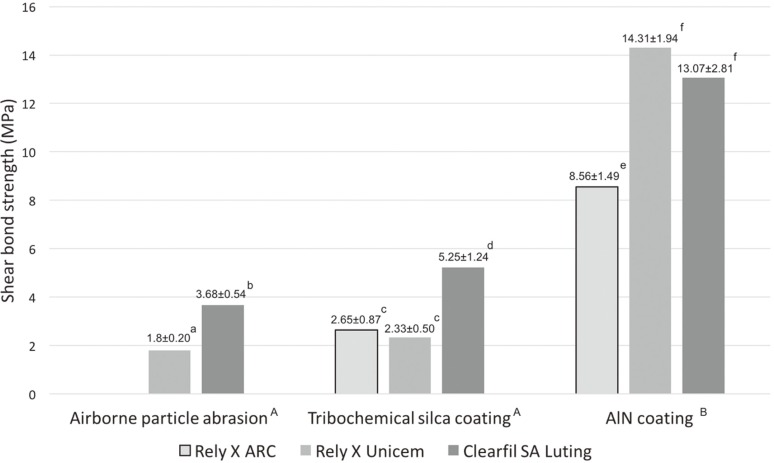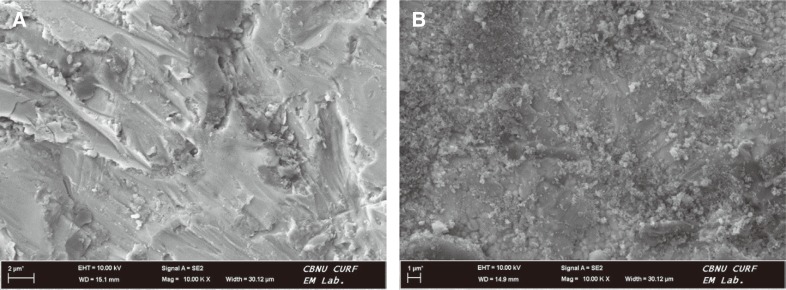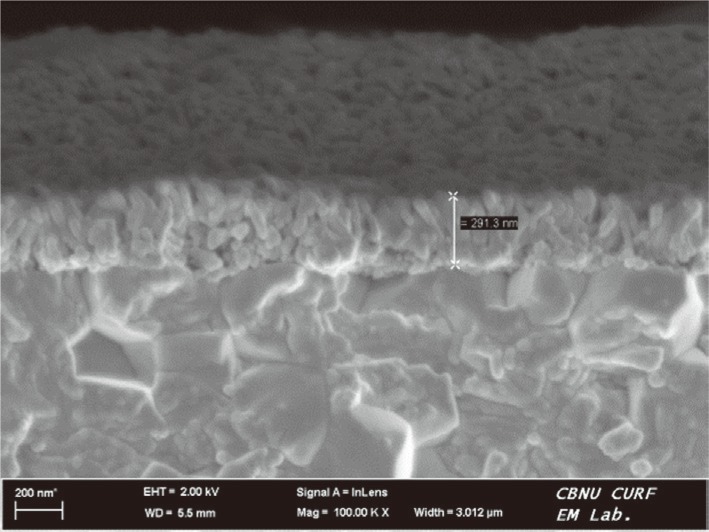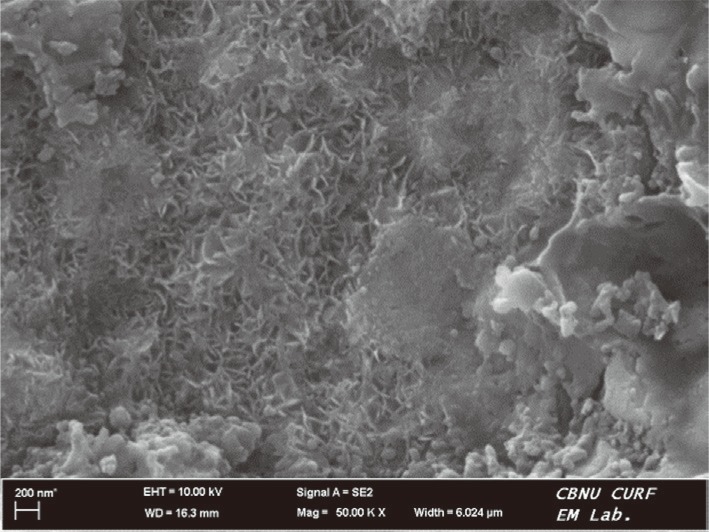J Adv Prosthodont.
2017 Apr;9(2):130-137. 10.4047/jap.2017.9.2.130.
Influence of nano-structured alumina coating on shear bond strength between Y-TZP ceramic and various dual-cured resin cements
- Affiliations
-
- 1Department of Prosthodontics and Institute of Oral Bio-Science, School of Dentistry, Chonbuk National University, and Research Institute of Clinical Medicine of Chonbuk National University-Biomedical Research Institute, Chonbuk National University Hospita
- KMID: 2376301
- DOI: http://doi.org/10.4047/jap.2017.9.2.130
Abstract
- PURPOSE
The purpose of this study was to evaluate the effect of nano-structured alumina surface coating on shear bond strength between Y-TZP ceramic and various dual-cured resin cements.
MATERIALS AND METHODS
A total of 90 disk-shaped zirconia specimens (HASS CO., Gangneung, Korea) were divided into three groups by surface treatment method: (1) airborne particle abrasion, (2) tribochemicalsilica coating, and (3) nano-structured alumina coating. Each group was categorized into three subgroups of ten specimens and bonded with three different types of dual-cured resin cements. After thermocycling, shear bond strength was measured and failure modes were observed through FE-SEM. Two-way ANOVA and the Tukey's HSD test were performed to determine the effects of surface treatment method and type of cement on bond strength (P<.05). To confirm the correlation of surface treatment and failure mode, the Chi-square test was used.
RESULTS
Groups treated with the nanostructured alumina coating showed significantly higher shear bond strength compared to other groups treated with airborne particle abrasion or tribochemical silica coating. Clearfil SA Luting showed a significantly higher shear bond strength compared to RelyX ARC and RelyX Unicem. The cohesive failure mode was observed to be dominant in the groups treated with nano-structured alumina coating, while the adhesive failure mode was prevalent in the groups treated with either airborne particle abrasion or tribochemical silica coating.
CONCLUSION
Nano-structured alumina coating is an effective zirconia surface treatment method for enhancing the bond strength between Y-TZP ceramic and various dual-cured resin cements.
MeSH Terms
Figure
Reference
-
1. Blatz MB. Long-term clinical success of all-ceramic posterior restorations. Quintessence Int. 2002; 33:415–426. PMID: 12073722.2. Ozcan M, Vallittu PK. Effect of surface conditioning methods on the bond strength of luting cement to ceramics. Dent Mater. 2003; 19:725–731. PMID: 14511730.3. Zidan O, Ferguson GC. The retention of complete crowns prepared with three different tapers and luted with four different cements. J Prosthet Dent. 2003; 89:565–571. PMID: 12815350.
Article4. Kelly JR, Nishimura I, Campbell SD. Ceramics in dentistry: historical roots and current perspectives. J Prosthet Dent. 1996; 75:18–32. PMID: 9005250.
Article5. Manicone PF, Rossi Iommetti P, Raffaelli L. An overview of zirconia ceramics: basic properties and clinical applications. J Dent. 2007; 35:819–826. PMID: 17825465.
Article6. Derand T, Molin M, Kvam K. Bond strength of composite luting cement to zirconia ceramic surfaces. Dent Mater. 2005; 21:1158–1162. PMID: 16005508.
Article7. Zhang Y, Lawn BR, Rekow ED, Thompson VP. Effect of sandblasting on the long-term performance of dental ceramics. J Biomed Mater Res B Appl Biomater. 2004; 71:381–386. PMID: 15386395.
Article8. Wang H, Aboushelib MN, Feilzer AJ. Strength influencing variables on CAD/CAM zirconia frameworks. Dent Mater. 2008; 24:633–638. PMID: 17765301.
Article9. Bottino MA, Valandro LF, Scotti R, Buso L. Effect of surface treatments on the resin bond to zirconium-based ceramic. Int J Prosthodont. 2005; 18:60–65. PMID: 15754894.
Article10. Wegner SM, Kern M. Long-term resin bond strength to zirconia ceramic. J Adhes Dent. 2000; 2:139–147. PMID: 11317401.11. Aboushelib MN, Matinlinna JP, Salameh Z, Ounsi H. Innovations in bonding to zirconia-based materials: Part I. Dent Mater. 2008; 24:1268–1272. PMID: 18417204.
Article12. Aboushelib MN, Mirmohamadi H, Matinlinna JP, Kukk E, Ounsi HF, Salameh Z. Innovations in bonding to zirconiabased materials. Part II: Focusing on chemical interactions. Dent Mater. 2009; 25:989–993. PMID: 19324404.
Article13. Mirmohammadi H, Aboushelib MN, Salameh Z, Feilzer AJ, Kleverlaan CJ. Innovations in bonding to zirconia based ceramics: Part III. Phosphate monomer resin cements. Dent Mater. 2010; 26:786–792. PMID: 20494433.
Article14. Özcan M, Kerkdijk S, Valandro LF. Comparison of resin cement adhesion to Y-TZP ceramic following manufacturers' instructions of the cements only. Clin Oral Investig. 2008; 12:279–282.
Article15. Jevnikar P, Krnel K, Kocjan A, Funduk N, Kosmac T. The effect of nano-structured alumina coating on resin-bond strength to zirconia ceramics. Dent Mater. 2010; 26:688–696. PMID: 20381854.
Article16. Amaral R, Ozcan M, Bottino MA, Valandro LF. Microtensile bond strength of a resin cement to glass infiltrated zirconia-reinforced ceramic: the effect of surface conditioning. Dent Mater. 2006; 22:283–290. PMID: 16039705.
Article17. Inokoshi M, De Munck J, Minakuchi S, Van Meerbeek B. Meta-analysis of bonding effectiveness to zirconia ceramics. J Dent Res. 2014; 93:329–334. PMID: 24563487.
Article18. Kern M, Wegner SM. Bonding to zirconia ceramic: adhesion methods and their durability. Dent Mater. 1998; 14:64–71. PMID: 9972153.
Article19. Kumbuloglu O, Lassila LV, User A, Vallittu PK. Bonding of resin composite luting cements to zirconium oxide by two air-particle abrasion methods. Oper Dent. 2006; 31:248–255. PMID: 16827029.
Article20. Blatz MB, Chiche G, Holst S, Sadan A. Influence of surface treatment and simulated aging on bond strengths of luting agents to zirconia. Quintessence Int. 2007; 38:745–753. PMID: 17873981.21. Blixt M, Adamczak E, Lindén LA, Odén A, Arvidson K. Bonding to densely sintered alumina surfaces: effect of sandblasting and silica coating on shear bond strength of luting cements. Int J Prosthodont. 2000; 13:221–226. PMID: 11203636.22. Matinlinna JP, Heikkinen T, Ozcan M, Lassila LV, Vallittu PK. Evaluation of resin adhesion to zirconia ceramic using some organosilanes. Dent Mater. 2006; 22:824–831. PMID: 16388846.
Article23. Lüthy H, Loeffel O, Hammerle CH. Effect of thermocycling on bond strength of luting cements to zirconia ceramic. Dent Mater. 2006; 22:195–200. PMID: 16143382.24. Palacios RP, Johnson GH, Phillips KM, Raigrodski AJ. Retention of zirconium oxide ceramic crowns with three types of cement. J Prosthet Dent. 2006; 96:104–114. PMID: 16911887.
Article25. de Oyagüe RC, Monticelli F, Toledano M, Osorio E, Ferrari M, Osorio R. Influence of surface treatments and resin cement selection on bonding to densely-sintered zirconium-oxide ceramic. Dent Mater. 2009; 25:172–179. PMID: 18620746.
Article26. Wegner SM, Gerdes W, Kern M. Effect of different artificial aging conditions on ceramic-composite bond strength. Int J Prosthodont. 2002; 15:267–272. PMID: 12066490.27. Uo M, Sjögren G, Sundh A, Goto M, Watari F, Bergman M. Effect of surface condition of dental zirconia ceramic (Denzir) on bonding. Dent Mater J. 2006; 25:626–631. PMID: 17076338.
Article28. Zhang Y, Lawn BR, Malament KA, Van Thompson P, Rekow ED. Damage accumulation and fatigue life of particle-abraded ceramics. Int J Prosthodont. 2006; 19:442–448. PMID: 17323721.29. Phark JH, Duarte S Jr, Blatz M, Sadan A. An in vitro evalua-tion of the long-term resin bond to a new densely sintered high-purity zirconium-oxide ceramic surface. J Prosthet Dent. 2009; 101:29–38. PMID: 19105989.
Article30. Karakoca S, Yilmaz H. Influence of surface treatments on surface roughness, phase transformation, and biaxial flexural strength of Y-TZP ceramics. J Biomed Mater Res B Appl Biomater. 2009; 91:930–937. PMID: 19637376.
Article31. Gomes AL, Castillo-Oyagüe R, Lynch CD, Montero J, Albaladejo A. Influence of sandblasting granulometry and resin cement composition on microtensile bond strength to zirconia ceramic for dental prosthetic frameworks. J Dent. 2013; 41:31–41. PMID: 23022106.
- Full Text Links
- Actions
-
Cited
- CITED
-
- Close
- Share
- Similar articles
-
- Influence of nano-structured alumina coating treatment on shear bond strength between zirconia ceramic and resin cement
- The influence of surface conditioning on the shear bond strength of self-adhesive resin cement to zirconia ceramics
- Effect of surface treatments of zirconia ceramic on the bond strength of resin cements
- Effect of tribochemical silica coating on the shear bond strength of rebonded monocrystalline ceramic brackets
- Evaluation of shear bond strength between dual cure resin cement and zirconia ceramic after thermocycling treatment








